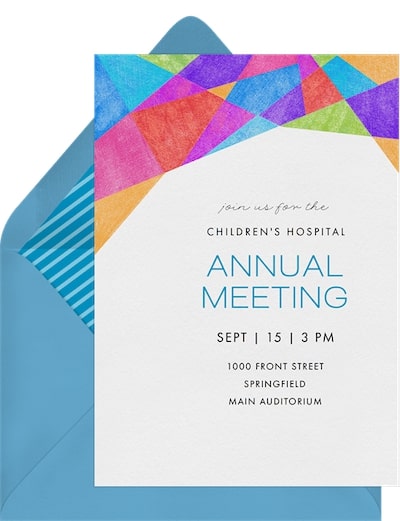PTA Meeting Tips and Ideas for Collaborative and Engaging Events

Parent-Teacher Association (PTA) meetings are an important tool for building partnerships between parents, school staff, and community members. If you’re in charge of running a PTA meeting, you’ll need to be an effective planner and communicator.
Here, we are sharing some of our top tips for creating engaging and collaborative PTA meetings, from simple reminders like greeting attendees at the door to guidelines on structuring the meeting.
10 Tips for Creating an Effective PTA Meeting

PTA meetings are important advocacy and fundraising events for the school community. They not only offer a platform for the executive board and PTA president to share news and insights, but they also offer a forum for local community members, parents, and sometimes students to express ideas and concerns. These meetings cover everything from school safety and student wellness to assessments and new programs.
Consider the following tips to create a collaborative, efficient, and effective PTA meeting from the elementary school level through high school.
1. Identify the Goal and Prepare an Agenda
As with any meeting, every PTA meeting should have a purpose. Before scheduling the meeting, determine what the main goal of the meeting is — maybe it’s discussing ways to improve your child’s school environment with a new vegetable garden or addressing an upcoming fundraiser. Once you have an objective in mind, you can plan a line-item agenda that helps guide discussion to meet that goal.Â
Before the meeting, send the agenda to key stakeholders such as student leaders from the Parent Teacher Student Association (PTSA), committee chairs, and officers. Ask for feedback on items to add to the agenda and then finalize it.
2. Choose an Appropriate Location
Local PTA meetings take place throughout the school year, so it’s important to pick a convenient location that can accommodate all attendees. Usually, a PTA meeting takes place on campus, such as in a conference room, office, or gymnasium. Be sure to check with any pertinent personnel to secure the space. It’s also important to select and announce meeting dates several weeks in advance so that invitees can make arrangements to attend.Â
3. Prepare Meeting Materials

Once you know the purpose of the meeting and the general timeframe, you can start preparing essential materials. Each meeting is different, but you may need to prep a PowerPoint presentation, print out informational pamphlets, or plan for a guest speaker.Â
4. Invite Stakeholders to Every Meeting

Design: Laura Bolter Design
Invitation Inspiration: Bold Geometric Invitation
No meeting can be successful if no one knows about it. For the most convenience and efficiency, send business invitations that you can easily customize to suit your event. Be sure to give guests plenty of time to plan to attend. Typically, PTA meeting invites should be sent two to four weeks before the meeting. This gives everyone enough time to plan their schedules so they can attend.
5. Create an Inclusive Environment and Encourage Participation
While PTA events are designed to conduct official business, they should also encourage participation and foster an inclusive environment. A great PTA meeting will encourage family engagement and get input from parents and community members.
Here are a few ways to increase collaboration and engagement:
- Have greeters at the door: Make attendees comfortable by having parents, staff, or students greet people at the door. They can answer questions, engage in conversation, and lighten the mood.
- Prepare materials in several languages: Create an inclusive environment by preparing documents in languages including English, Spanish, Chinese, Tagalog, or French. Consider who attends your public schools and provide documentation in languages that the community, parents, or staff speak.
- Provide name tags: Make everyone feel more comfortable by handing out name tags. This way, everyone is comfortable addressing other attendees by name.
- Offer snacks and refreshments: While meetings shouldn’t be longer than an hour, refreshments are an excellent way to break the ice and keep people happy during the discussions.
- Schedule time in the agenda for dialogue: People want to be heard, so set aside time for discussion during the meeting. You can ask attendees to volunteer suggestions and opinions on the agenda items.
- Provide childcare: Many high school and middle school students are required to do some form of community service. Ask older, responsible kids to handle childcare during the meeting if it aligns with local guidelines. You can also ask school staff to supervise the child care to ensure safety and order.Â
6. Consider Decision-Makers
If your PTA meeting involves voting topics, make note of the voting members, including PTA board members. Since voting is limited to eligible members, you want to be sure who’s allowed to vote and who isn’t.Â
Eligible voting members can change depending on the type of board meeting you’re hosting. If it’s a board meeting, only board members can vote. If it’s a general membership meeting, only members can vote. For committee meetings, only members of the committee have voting powers.
Keep in mind that voting is always done in person. Refer to your local and state PTA bylaws for more details on quorum and voting as these are specific to location.Â
7. Get Creative With a Themed Meeting

Design: Claudia Owen
Invitation Inspiration: Two Tone Circle Invitation
Everyone has a busy schedule, and PTA meetings can feel like a chore for some. To boost attendance, make it a fun experience. Schedule a themed meeting around seasonal holidays. You can host an ugly sweater party (er, meeting) around the holidays or schedule a potluck-style event. Give students a role in the creativity by having them come up with themed meeting ideas. It can also be as simple as emphasizing school colors and throwing in some fun trivia to engage your attendees.
8. Take Training Courses
As a PTA leader, training can help you conduct more effective PTA meetings. Sign up for the National PTA’s School of Excellence Program to learn skills and techniques to build better partnerships within your school and with the community at large.Â
9. Stick to a Timeline

Design: Ink & Letter
Invitation inspiration: Bright Watercolor Invitation
It’s a good rule of thumb to keep your PTA meeting to under an hour and stick to the agenda. Before the meeting, go through the agenda and assign a time slot for each item that needs to be discussed. Ask the secretary or someone to keep track of meeting minutes and move things along before an agenda item takes up too much of the meeting time.
10. Create Follow-Up Meeting Documentation
While there’s a lot of work that goes into preparing for a PTA meeting, your job isn’t done when the meeting adjourns. Create follow-up documentation to track any actionable items. Ask someone to take meeting notes and send these out after the event to remind attendees of the key takeaways.Â
Use follow-up surveys to generate insights from community members on things that can be improved. These can include procedural changes like venues and agendas as well as potential discussion topics for future meetings.
Get Things Done At Your Next PTA Meeting
With these tips, you’ll plan better and more effective PTA meetings that maximize engagement and collaboration. When you’re ready to invite guests, look no further than Greenvelope’s collection of PTA meeting invitations. Choose a design, then customize it by changing the color scheme — to school colors, for example — and update the message to suit your event.Â
Aside from saving trees, time, and money, digital invitations let you quickly upload all your attendee contacts and hit send to deliver via email or text. Plus, you can use the online dashboard to track RSVPs seamlessly. If something changes, you can easily send out an update with just a few clicks. That means you’ll have more time to focus on the important stuff like building connections and improving your school community.


